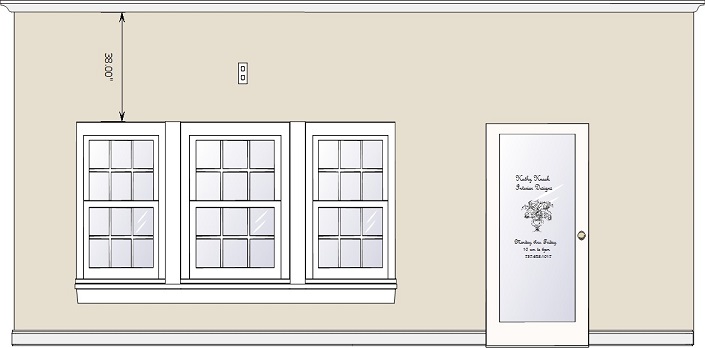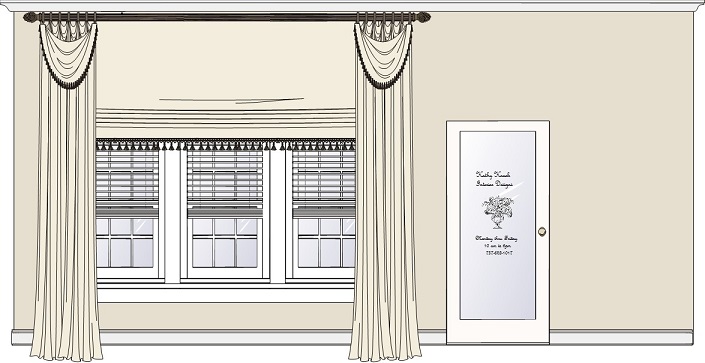Window treatments… every homeowners’ dilemma or nightmare! You choose!
And are they really necessary?
Personally, I love window treatments. I love how they transform a room by adding visual (and sometimes physical) warmth, texture, color and pattern to the space. As an important accessory, window treatments complete a room.
And sometimes, having no window treatment is the right answer too. But for those of you who like the idea of having some type of window treatment at your windows, this blog is for you!
There are 2 categories of window treatments. There are “hard” treatments which include shutters, blinds, woven wood shades, vinyl roller shades, pleated shades, cornices and lambrequins. Then there are “soft” treatments…ones made from fabrics…drapery panels, sheers, valances, and roman shades. And, of course, there is the combination of both.
No matter what you choose to do, window treatments are an expensive undertaking. So it’s important to get it right the first time! Mistakes are costly!
My rule in designing window treatments is to
create as much height as possible. Always draw the eye upwards, not horizontally. My storefront window is a good one example. It is a triple window unit, very horizontal. Lots of great light!! .I wanted a layered look with both hard and soft treatments. And I wanted the window treatment to feel like you were in a home, not a store! But there were issues! There was 3 feet + of dead space from the top of the window to the ceiling line…. And in the middle of that 38” dead space, there was an electrical outlet!!!! What??? How was I going to hide that?
Planning and drawing of the “problem child” window was where I started. Doing a scaled drawing of any window helps you see how the concept will translate into a visual. And when my clients call me to help with their windows, particularly difficult ones, this is the first thing I do. This way, as different ideas come to mind in the planning process, they can be “tried out on paper” before the first yard of fabric is cut.
Also, during the drawing process, actual construction measurements can be applied in the drawings so the proportion, scale and balance of the design idea can be seen. Many window treatments miss the mark because the designer and fabricator haven’t taken into account how the 3 basic concepts of good design impact window treatments… scale, balance and proportion. A scaled drawing of Kathy Knack Interior Designs’ “naked” window was my beginning. Every detail of the window wall was measured.

The store window was a challenge because of the 3 feet of soffit area with an outlet above the top of the window. The ceiling height was 10 feet. The windows was out of proportion to the wall height. A light control/privacy option was the first selection. It had to be something that could stand alone for a while.

A hard treatment of 2” wooden plantation blinds was selected because it provided both light control and privacy, as needed. This was an easy choice for me. It was the beginning…the first layer of Kathy Knack Interior Designs window treatment.
When a window is wide, create height with a vertical line. By taking a treatment to the ceiling line, it draws the eye upwards. So drapery panels were the perfect option. Also, I love the softness panels bring to a window and how they create that soft vertical line. However, panels alone would not hide that ugly outlet in the middle of that 38” soffit space above the windows. A valance top treatment wasn’t an option because it would be too deep and over scale. So, the question still remained, how to hide that outlet! An interior design dilemma!
Ah..Ha!! What about a soft roman shade window treatment…better yet, a “mock” roman shade? A mock roman is stationary fabric shade, tied off in place so it is not raised or lowered for privacy. Placed behind the wooden drapery pole, the soft flat roman fabric shade would hide the outlet and create the illusion that the windows were much taller than they actually are (again, creating height)! So, just to make sure the idea would work, a scaled drawing confirmed the vision. A soft neutral dupioni silk which had a soft reflective luster was selected for the shade. A complimentary large neutral plaid silk was selected for the drapery panels.
Just as the type of fabric selected is important ( never pick a fabric that is 100% linen, as it “walks” or goes up and down with climate changes), so are the “accessories…aka details!
Details add to the overall window treatment look. Trim, braids, banding, etc. add an additional layer of visual depth and interest. Without these details, it’s just plain old drapery panels…boring interior design!!!
Also important in window treatment interior design is the unseen element…interlining. Along with regular lining which backs the fabric, interlining, a layer of lining between the fabric and the “outside” lining, gives draperies additional body. It also another layer that protects the fabric from sun fading. With silks, specifically, I like to use English flannel (aka Bump) which gives silk more body for draping and its extra thickness helps protects the silk from the sun’s harsh rays.
Here is the concept of the window treatment idea in a scaled drawing. The addition of a soft casual swag with trim added a touch of formality to the informal treatment.

Not every window treatment needs to be this elaborate …but for a “problem” window like Kathy Knack Interior Designs showroom window, it is the best solution. It gives the showroom an inviting, welcoming feel. It shows the customer 3 types of treatments. The hard treatment, blinds, and 2 types of soft treatments, fabric roman shades, and stationary panels.
Finally, the client’s wishes and input should always guide the design. Is the client a minimalist? Does the client like lots of embellishments; lots of layers? Is privacy important? Asking questions like these help in formulating a good overall design. Finding an interior designer who understands that all windows are not the same, that “one design style doesn’t fit all windows” and understands how scale, balance and proportions are important when designing window treatments, is critical. And working with an interior design professional who has a reputable workroom that can construct and install quality window treatments is important in transforming a concept into reality.
So, how did Kathy Knack Interior Designs’ “drawing concept” translate into reality? Take a look! What do you think?

So, remember with any window treatment concept, it should always reflect your style, and function as your needs require. Seek out an interior design professional who can help you find the right window treatment to enhance your room. If you are spending your hard earn money, spend it wisely and with an interior design professional you trust to bring your vision to reality!
